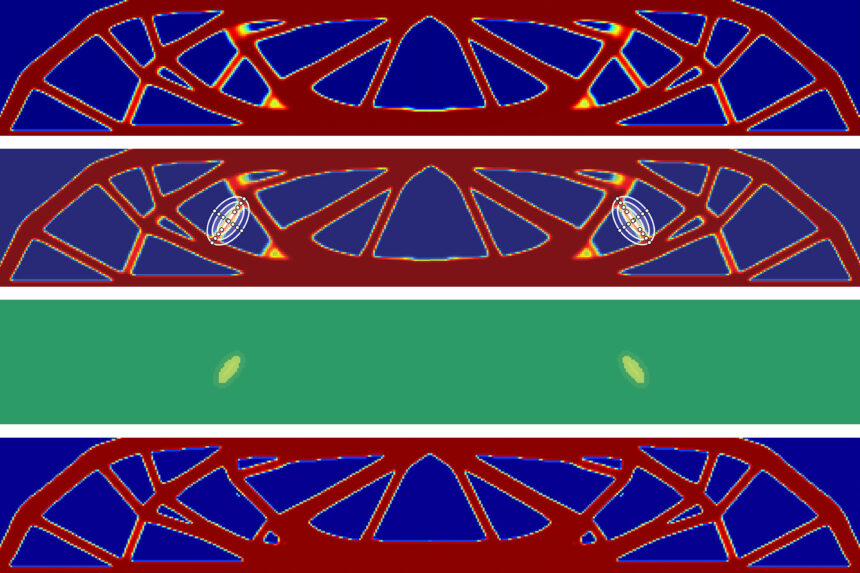Modern fabrication tools such as 3D printers can make structural materials in shapes that would have been difficult or impossible using conventional tools. Meanwhile, new generative design systems can take great advantage of this flexibility to create innovative designs for parts of a new building, car, or virtually any other device.
But such “black box” automated systems often fall short of producing designs that are fully optimized for their purpose, such as providing the greatest strength in proportion to weight or minimizing the amount of material needed to support a given load. Fully manual design, on the other hand, is time-consuming and labor-intensive.
Now, researchers at MIT have found a way to achieve some of the best of both of these approaches. They used an automated design system but stopped the process periodically to allow human engineers to evaluate the work in progress and make tweaks or adjustments before letting the computer resume its design process. Introducing a few of these iterations produced results that performed better than those designed by the automated system alone, and the process was completed more quickly compared to the fully manual approach.
The results are reported this week in the journal Structural and Multidisciplinary Optimization, in a paper by MIT doctoral student Dat Ha and assistant professor of civil and environmental engineering Josephine Carstensen.
The basic approach can be applied to a broad range of scales and applications, Carstensen explains, for the design of everything from biomedical devices to nanoscale materials to structural support members of a skyscraper. Already, automated design systems have found many applications. “If we can make things in a better way, if we can make whatever we want, why not make it better?” she asks.
“It’s a way to take advantage of how we can make things in much more complex ways than we could in the past,” says Ha, adding that automated design systems have already begun to be widely used over the last decade in automotive and aerospace industries, where reducing weight while maintaining structural strength is a key need.
“You can take a lot of weight out of components, and in these two industries, everything is driven by weight,” he says. In some cases, such as internal components that aren’t visible, appearance is irrelevant, but for other structures aesthetics may be important as well. The new system makes it possible to optimize designs for visual as well as mechanical properties, and in such decisions the human touch is essential.
As a demonstration of their process in action, the researchers designed a number of structural load-bearing beams, such as might be used in a building or a bridge. In their iterations, they saw that the design has an area that could fail prematurely, so they selected that feature and required the program to address it. The computer system then revised the design accordingly, removing the highlighted strut and strengthening some other struts to compensate, and leading to an improved final design.
The process, which they call Human-Informed Topology Optimization, begins by setting out the needed specifications — for example, a beam needs to be this length, supported on two points at its ends, and must support this much of a load. “As we’re seeing the structure evolve on the computer screen in response to initial specification,” Carstensen says, “we interrupt the design and ask the user to judge it. The user can select, say, ‘I’m not a fan of this region, I’d like you to beef up or beef down this feature size requirement.’ And then the algorithm takes into account the user input.”
While the result is not as ideal as what might be produced by a fully rigorous yet significantly slower design algorithm that considers the underlying physics, she says it can be much better than a result generated by a rapid automated design system alone. “You don’t get something that’s quite as good, but that was not necessarily the goal. What we can show is that instead of using several hours to get something, we can use 10 minutes and get something much better than where we started off.”
The system can be used to optimize a design based on any desired properties, not just strength and weight. For example, it can be used to minimize fracture or buckling, or to reduce stresses in the material by softening corners.
Carstensen says, “We’re not looking to replace the seven-hour solution. If you have all the time and all the resources in the world, obviously you can run these and it’s going to give you the best solution.” But for many situations, such as designing replacement parts for equipment in a war zone or a disaster-relief area with limited computational power available, “then this kind of solution that catered directly to your needs would prevail.”
Similarly, for smaller companies manufacturing equipment in essentially “mom and pop” businesses, such a simplified system might be just the ticket. The new system they developed is not only simple and efficient to run on smaller computers, but it also requires far less training to produce useful results, Carstensen says. A basic two-dimensional version of the software, suitable for designing basic beams and structural parts, is freely available now online, she says, as the team continues to develop a full 3D version.
“The potential applications of Prof Carstensen’s research and tools are quite extraordinary,” says Christian Málaga-Chuquitaype, a professor of civil and environmental engineering at Imperial College London, who was not associated with this work. “With this work, her group is paving the way toward a truly synergistic human-machine design interaction.”
“By integrating engineering ‘intuition’ (or engineering ‘judgement’) into a rigorous yet computationally efficient topology optimization process, the human engineer is offered the possibility of guiding the creation of optimal structural configurations in a way that was not available to us before,” he adds. “Her findings have the potential to change the way engineers tackle ‘day-to-day’ design tasks.”
Read the full article here












